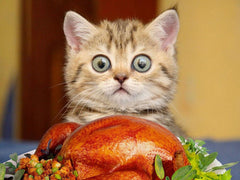Loss of Pet: Tips to handle the loss with a child
Posted by Yip & Purr on

“When a pet dies suddenly, it highlights the unpredictability of the world. It tells children that the people and animals they love can die without warning,” said Abigail Marks, a clinical psychologist in San Francisco who specializes in childhood grief.
The loss of a pet is often a child’s first experience with death. Understanding the unique ways that children view pets and respond to their passing can help parents to ease the grieving process.
Joshua Russell, an assistant professor of environmental science at Canisius College in Buffalo, who has studied the effects of pet loss in children, explained that for many children, pets are more than just animals. “Many kids describe their pets as siblings or best friends with whom they have strong connections,” he said.
In a study of 12 children ages 6 to 13 who had lost a pet, published in the journal Environmental Education Research, Dr. Russell found that even years after the pet’s death, some children still described the loss as “the worst day of their lives.” He also discovered that children come up with unique ways to rationalize their pet’s passing and that the way a pet dies influences how children grieve.
“Children, in particular, have a distinct sense of existential fairness around whether or not an animal lived until an appropriate age,” Dr. Russell said.
For most kids, pets are more than just animals their families own — they're members of the family and the best of friends.
Unfortunately, the joy of owning a pet goes hand-in-hand with the heartbreak of losing one, whether because of old age, illness, or an accident.
And that can be very difficult. After all, family pets often are the first to greet kids in the morning and after school. Your pet may be the one your child looks to for comfort and companionship when ill or feeling unpopular or upset.
While it's impossible to shelter kids from the loss of a pet, you can help them cope with it. And because a pet's death might be their first time losing a loved one, the grieving process can help kids learn how to cope with other losses throughout life.
Sharing the News and the Grief
One of the most difficult parts about losing a pet may be breaking the bad news to kids. Try to do so one-on-one in a place where they feel safe and comfortable and not easily distracted.
As you would with any tough issue, try to gauge how much information kids need to hear based on their age, maturity level, and life experience.
If your pet is very old or has a lingering illness, consider talking to kids before the death occurs. If you have to euthanize your pet, you may want to explain that:
* the veterinarians have done everything that they can
* your pet would never get better
* this is the kindest way to take the pet's pain away
* the pet will die peacefully, without feeling hurt or scared
Again, a child's age, maturity level, and questions will help determine whether to offer a clear and simple explanation for what's going to happen. If so, it's OK to use words like "death" and "dying" or to say something like "The veterinarian will give our pet a shot that first puts it to sleep and then stops the heart from beating." Many kids want a chance to say goodbye beforehand, and some may be old enough or emotionally mature enough to be there to comfort the pet during the process.
If you do have to euthanize your pet, be careful about saying the animal went "to sleep" or "got put to sleep." Young kids tend to interpret events literally, so this can conjure up scary misconceptions about sleep or surgery and anesthesia. If the pet's death is more sudden, calmly explain what has happened. Be brief, and let your child's questions guide how much information you provide.
Here are some tips to help your child and you cope with the loss of the loved pet.
1. Scrapbook

As a nurse, I believe in the “work of grieving,” and using one’s heart and hands makes this process concrete for a child. I printed pictures of Max, bought very simple scrapbooks, and asked the girls to make memory books. Many healthy tears were turned into treasured keepsakes in the weeks following his death.
2. Hold a ceremony

Holding a pet funeral is a very personal decision. Our daughters were too young to understand what a funeral was, and my invented ceremony was a disaster. At ages 9 and 11, Beluga-the-Hamster’s ceremony rivaled that of a sitting statesman. Our daughters buried a tiny casket in the pouring down rain while singing. A little kooky? Yes. Helpful? Absolutely.
3. Find and read helpful books
I’m a fan of “The Tenth Good Thing About Barney” by Judith Viorst. It addresses grief in a child’s voice, does not presuppose all readers believe in heaven, and does not end with the idea that a new pet will heal the sense of loss. It’s an elegantly simple picture book with the message that grief takes patience, and it’s a good thing to remember.
4. Make a memorial

Our family tradition is to plant something beautiful in the yard. We have climbing roses, weeping willows and flowers, all planted in memory of a person or animal. Our daughters also built a small memorial in the yard. Again, it was nothing formal, as it was far more meaningful to them that they made it themselves.
5. Make an ornament
If you celebrate any holiday involving tchotchkes, a memory piece is a lovely way to remember a pet. Every year we hang Max’s silliest picture on the Christmas tree, and honor that he will always be in our family.
Most children do not have comparative loss, and therefore a pet may be the equivalent grief of an adult losing a best friend.
It’s good to have feelings, even sad ones, and learning how to express and manage those feelings turns grieving into growth.
Perhaps most important, talk about your pet, often and with love. Let your child know that while the pain will eventually go away, the happy memories of the pet will always remain. When the time is right, you might consider adopting a new pet — not as a replacement, but as a way to welcome another animal friend into your family.


